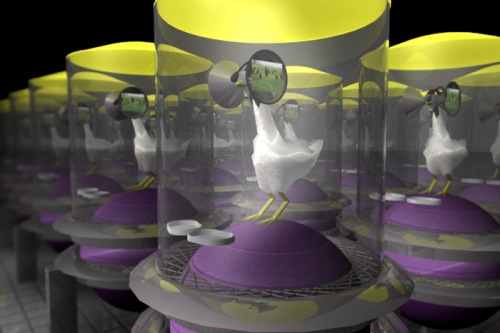I am not a vegetarian, but, 99% of the time, I will not eat meat.
I was raised a confirmed carnivore, and, having worked with animals for many years, I appreciate the food chain as well as anyone else, including the human position on (or near) its top. I double majored in biology and animal behavior. I understand that we are all protein in different packages, and that protein moves around the system most efficiently via predation.
The people who taught me that animals are intelligent, living things with their own needs and personalities also taught me that everyone in the household — including the animals — works for their living. While I took out the trash and cleaned the house, the dog defended it and provided ambiance; the cat caught the mice in the kitchen; the horse carted me around on its back in return for food and care. Cows, pigs, sheep, and chickens (should) likewise enjoy a peaceful life being cared for, fed, sheltered, and watered before turning in their service, feeding the rest of the household.
Thus I feel that there is no moral imperative not to eat meat. We are all (and this includes humans) required to work for our place in the world. If I feed, water, and shelter a cow, and provide her with medical care — if I treat her like any other member of my family — I should be able to ask her for her milk, and, at time of need, provide her with a humane death, and eat her. She will feed my family (and others!) for a month, properly apportioned. If I stopped working and paying the bills, I would soon not have a house to live in, or any food to eat. In the wild, animals work to obtain their own food, water, and shelter. Why should a cow not have to work for her living?
My issue arises when the life of a captive animal moves from “work” to “slavery” — when the animal is no longer paid for its efforts. This happens somewhere along the continuum from “small family farm” to “enormous animal factory”. A farmer handling 20 head of cattle can call each one by name, tell you her birthday and her social rank in the herd, her likes and dislikes, and her medical history. A farmer with 200 head of cattle has little time to spend with each individual. A corporation with 200,000 cattle uses a computer to tag and electronically track its bovine “assets”, which become managed by electronic gates and subsystems and by several tiers of employees.
Today, an unimaginable number of animals are “processed” each day. Large corporations, each encompassing dozens of farms, each farm managing hundreds of thousands of animals, provide most of our meat. The entropy of such a system is enormous, and even if it began with the animals fed, watered, sheltered, and vetted, soon the edges will wear and corners will be cut. Animals cannot be paid for their work — they can barely be counted. When one “unit” “breaks down”, it is simply discarded — there are millions of others to take its place. There is no time, when herding 10,000 cows a day through the milker, to be patient with a nervous cow, to notice impending mastitis, to separate a single animal to treat a small wound. The process cannot be stopped. In such a system, a dead animal is simply one who has reached the end of the assembly line early. It can still be used: if not for human food, then for pet food, fertilizer, cosmetics.
The animals receive the bare minimum of care necessary to maintain them in an “alive” state, because they are (marginally) more useful alive and certainly easier to transport. No time can be devoted to anything more than the minimum. In the rush, things get delayed, ignored, forgotten. Employees get overwhelmed and frustrated, and take out their anger on the animals. Procedures are performed en masse, and if individuals cannot cope, they are culled. The budget is tight, and animals cannot form a union and strike for better pay.
The methods of an animal’s eventual death under such a system — the “humane slaughter” which is such an unbelievable oxymoron it makes my eyes water — is a topic for another post, or perhaps a hundred posts. It suffices to say that it isn’t, in any sense, the quick death free of pain and fear that all living things should receive. Nothing about the factory farming system works — especially not for the animals.
Most of our commercially available meat today comes from these titanic animal factories. While I love eating meat, and do not have any personal problem with eating another animal, I have all sorts of personal issues with the treatment of animals in such factories, and I will not eat animals which came from such places. This leaves me out of luck at restaurants, most public venues, and other people’s homes — basically anywhere that does not get its meat from a small, family farm which still has a low enough number of animals that they can afford to handle them humanely. These still exist, fortunately, and are becoming more popular, so now, with careful planning and researching, I am able to locate occasional meat-based products that do not involve the Great Machine. And thus I am not a vegetarian; but in 99% of cases, I will not eat meat.










